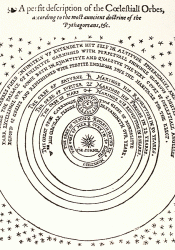Tycho and Galileo
After Copernicus had concluded that the sun was the center of the universe and that all other planets had an orbit around the sun, there was immense controversy. Many people had a hard time accepting the new Copernican system because it rejected the notions of the Ptolemaic system and even clashed with the conventions of the bible. The bible declines the idea of a stationary sun and a moving earth, and many Catholics and Protestants quickly rejected the idea. People such as Martin Luther openly dismissed the notion in one of his “table talks” in 1593. In light of this conflict Tycho Brahe created a new, hybrid model, a geostatic heliocentric model. In this system, the moon and the sun have an orbit around the earth and the other planets have an orbit around the sun. This accounted for Copernicus’ correct prediction of the movement of the planets but worked with the solidity of a stationary earth so that Aristotelian physics could be maintained. Many people adopted the new Tychonic cosmology, but Galileo Galilei changed all that. After Galileo’s invention of the telescope, the Tychonic system validity was questioned. He boldly questioned the new system and even called into question the bible’s knowledge on astronomy when he stated that the bible is written in the language of the common person, not in the language of an expert in astronomy. Galileo’s statements and arguments undermined the physics and astronomy of Aristotle and those before him. Galileo’s telescopic observations did not prove, nor disprove that the sun is the center of the universe, but it did add to his validity and urged people to consider the points he was sharing. Soon after, the heliocentric system was widely accepted.
Sources: "The Galileo Project." Rice University. http://galileo.rice.edu/sci/theories/copernican_system.html. Accessed 28 Feb. 2018.
Image source: Rice University. Public domain. http://galileo.rice.edu/sci/theories/copernican_system.html.

